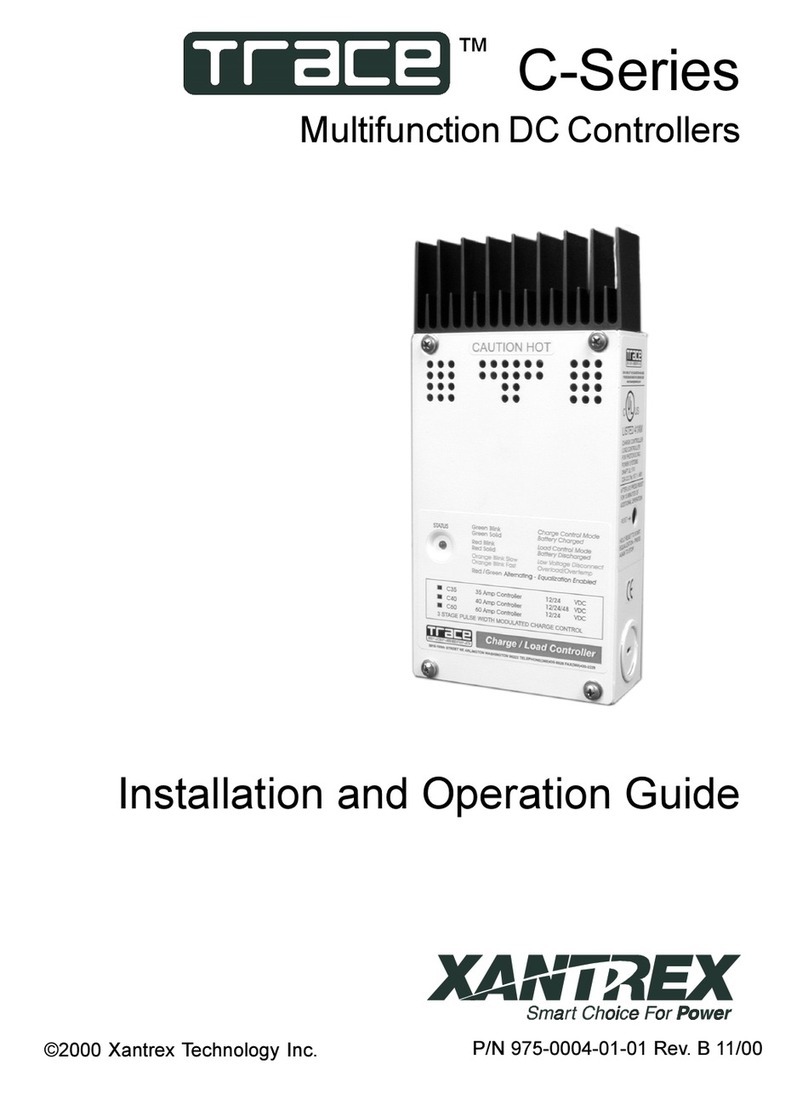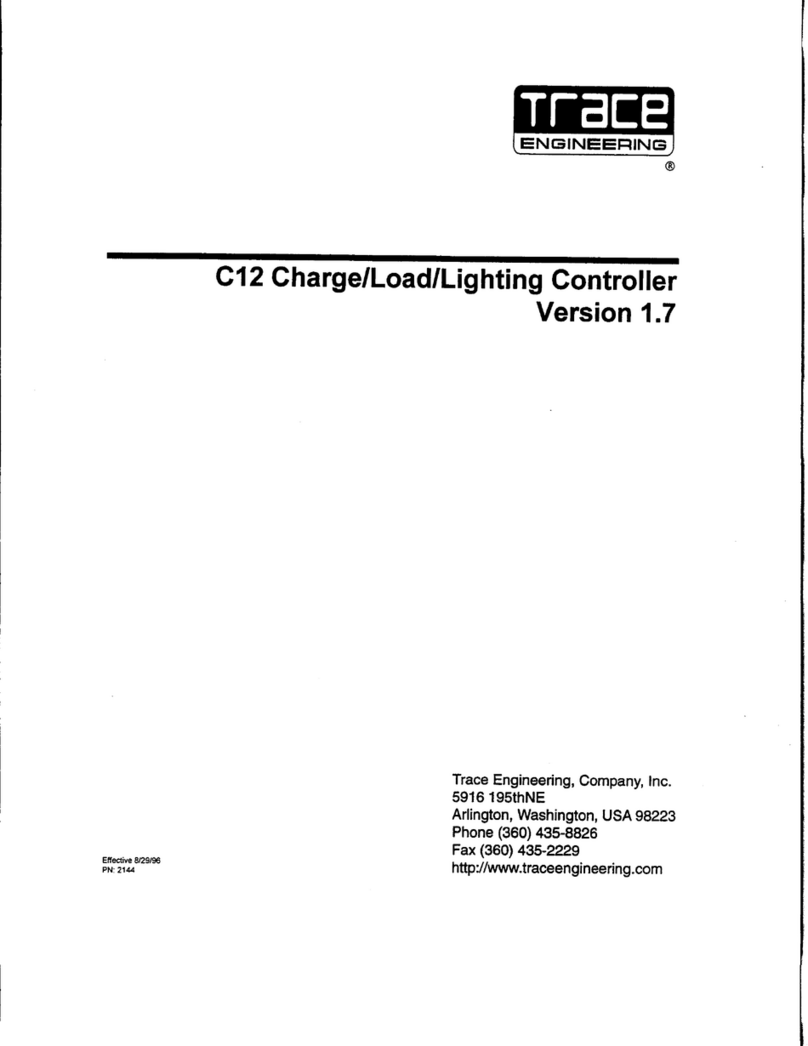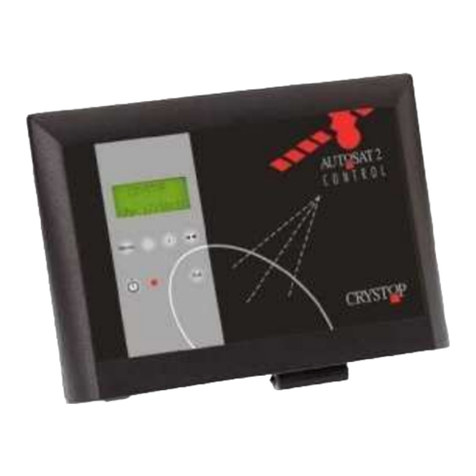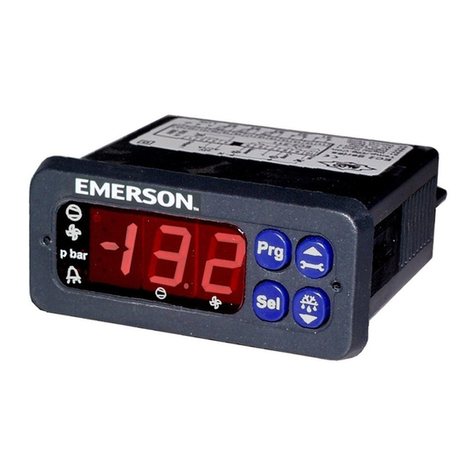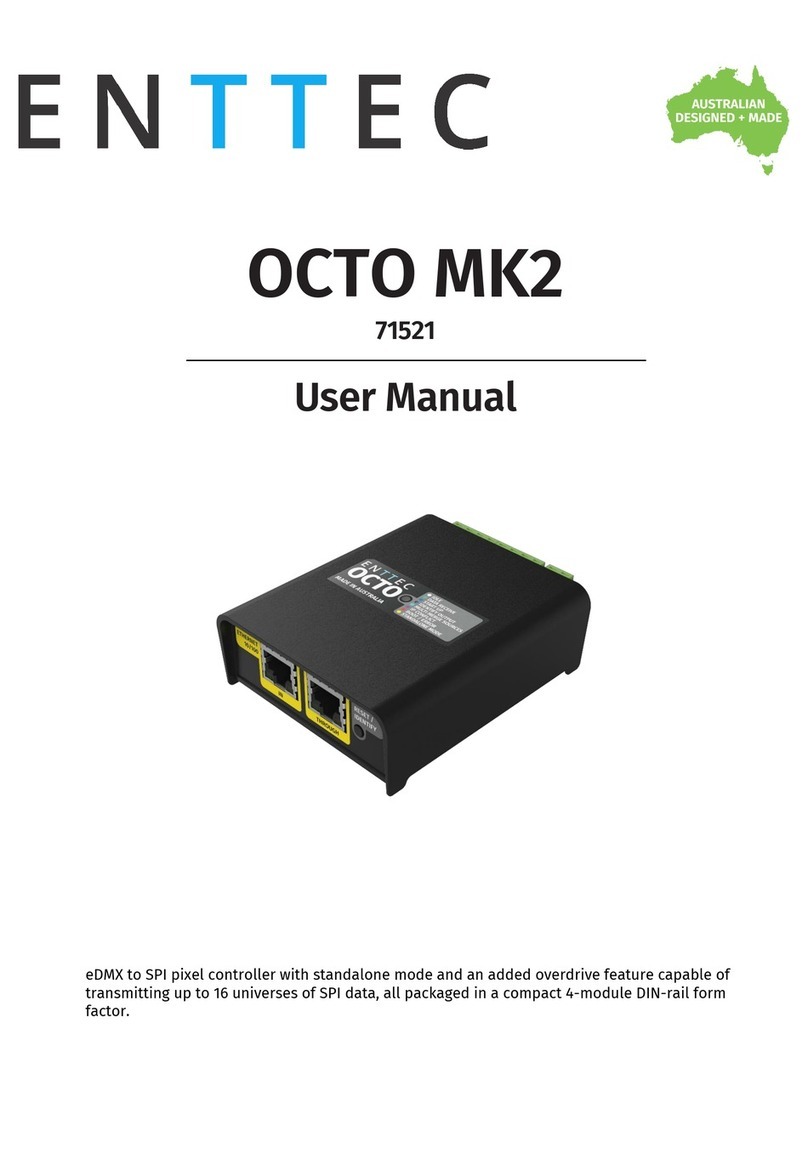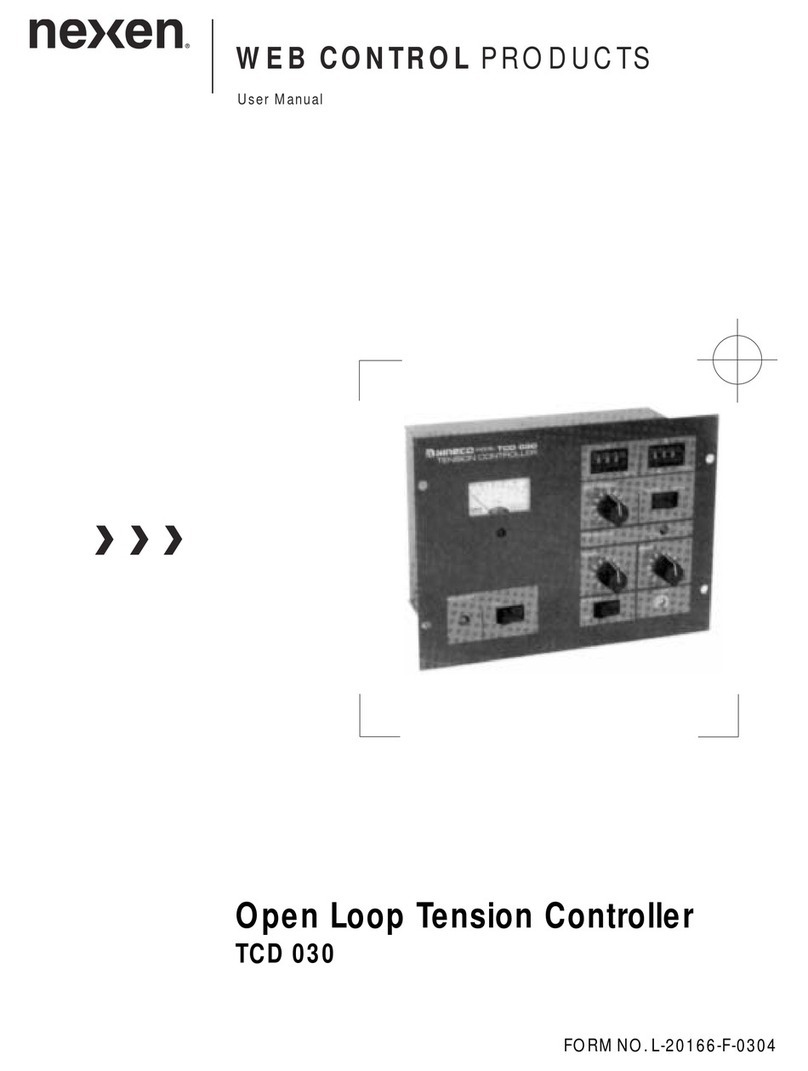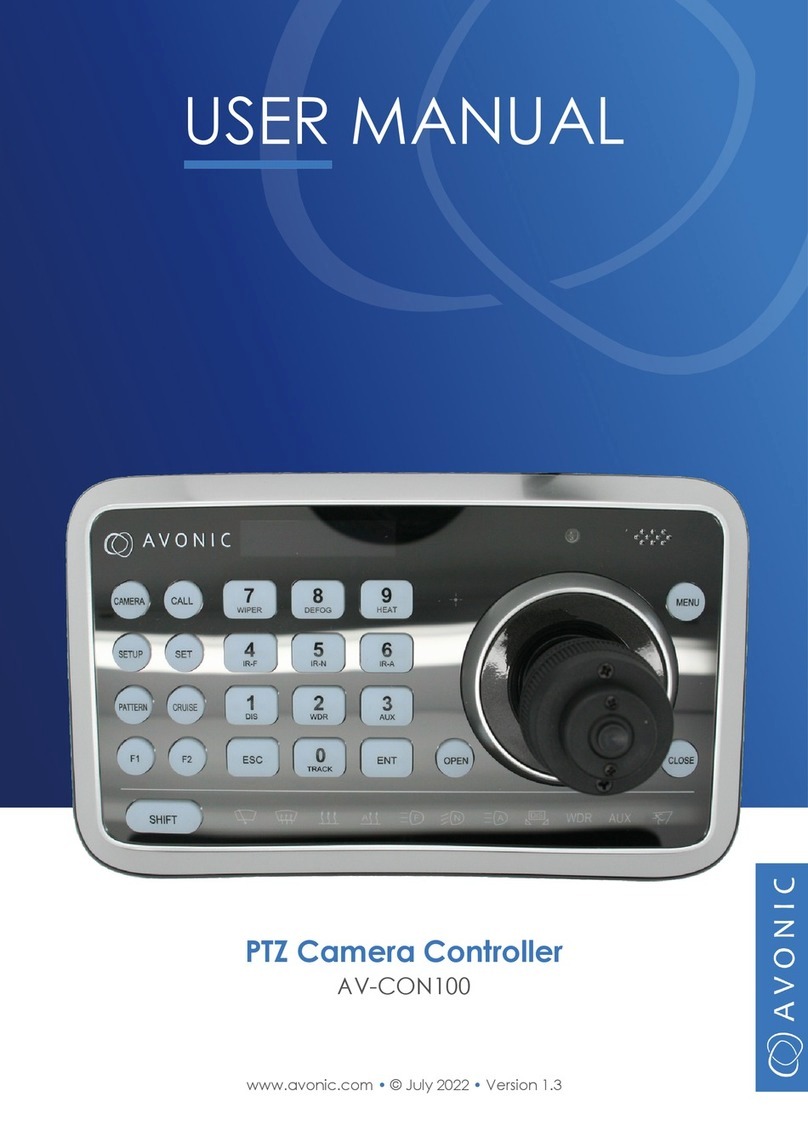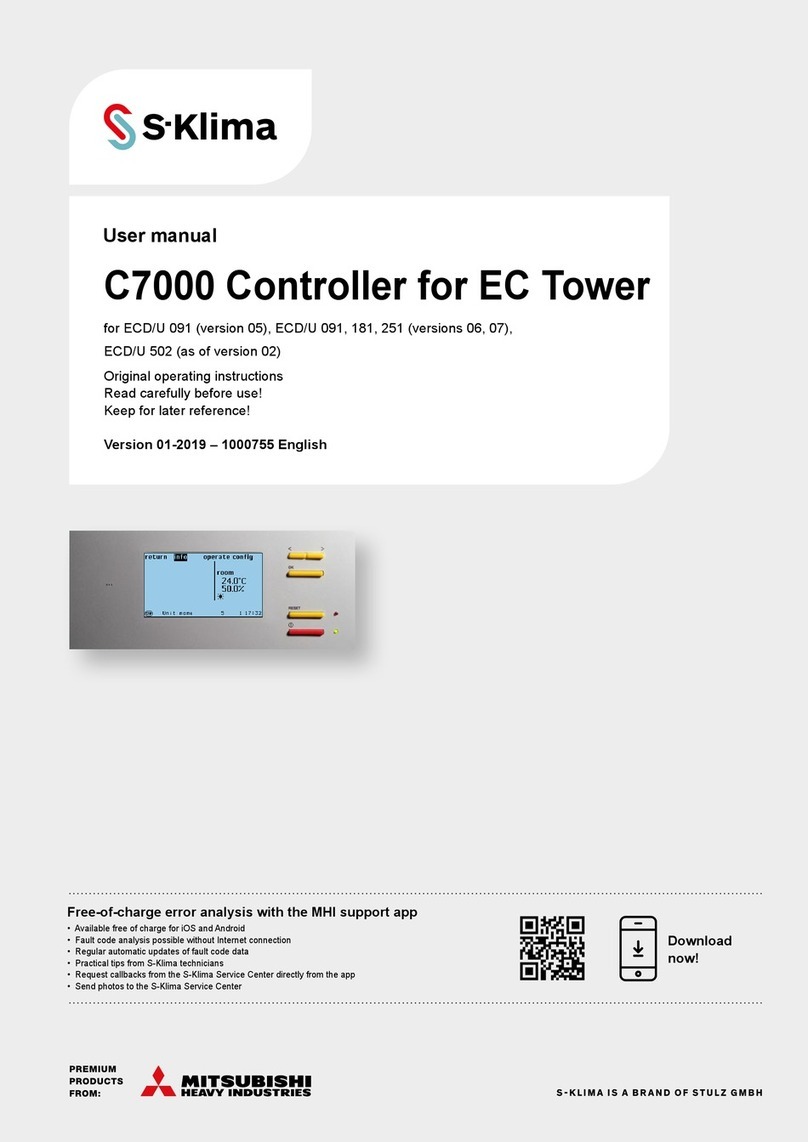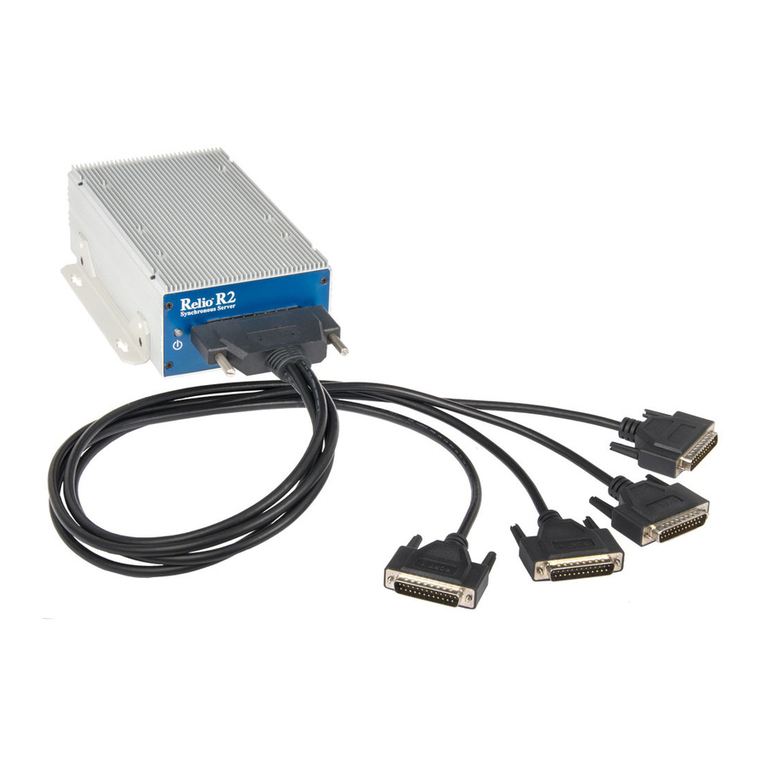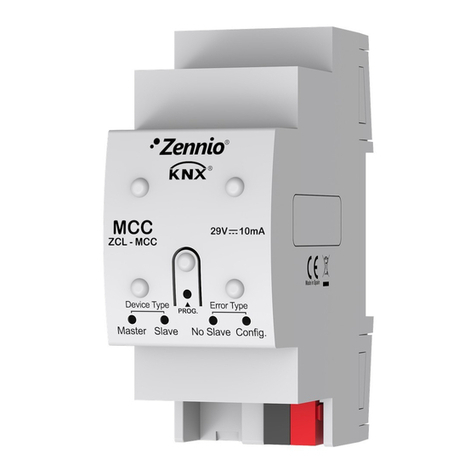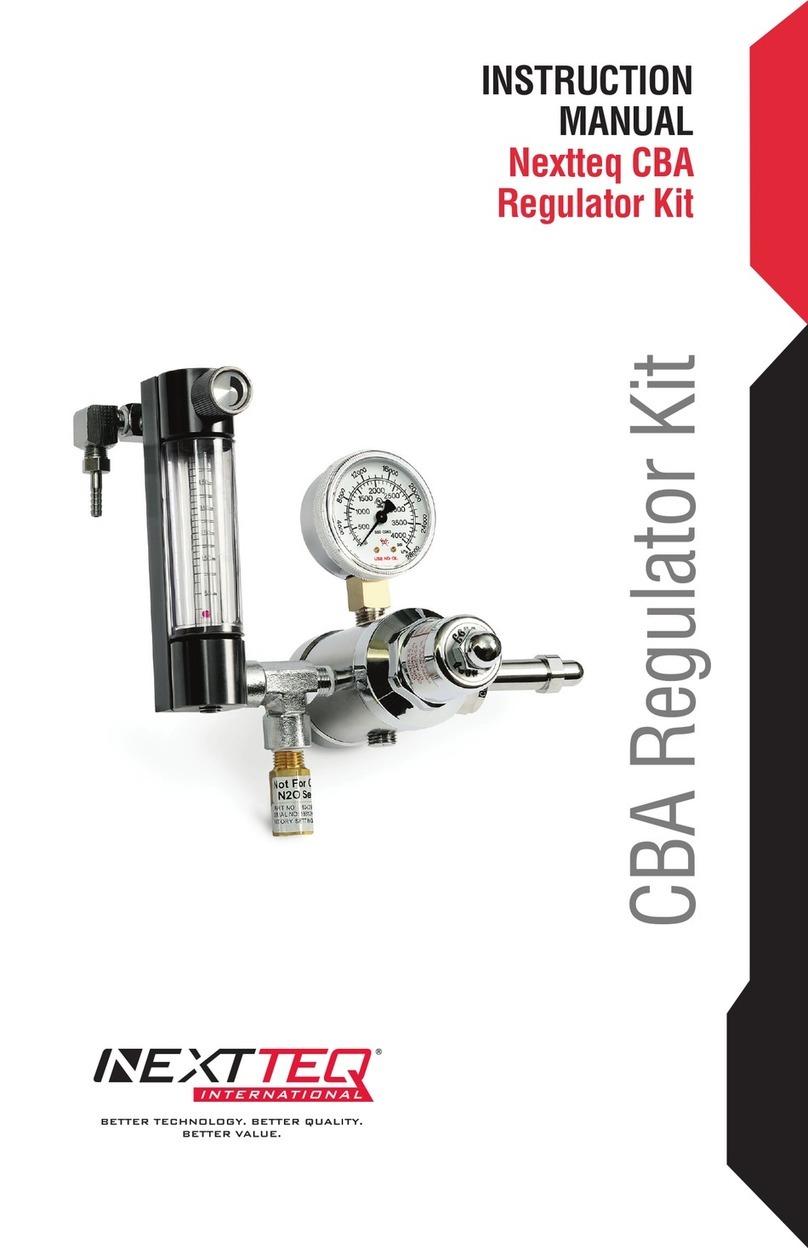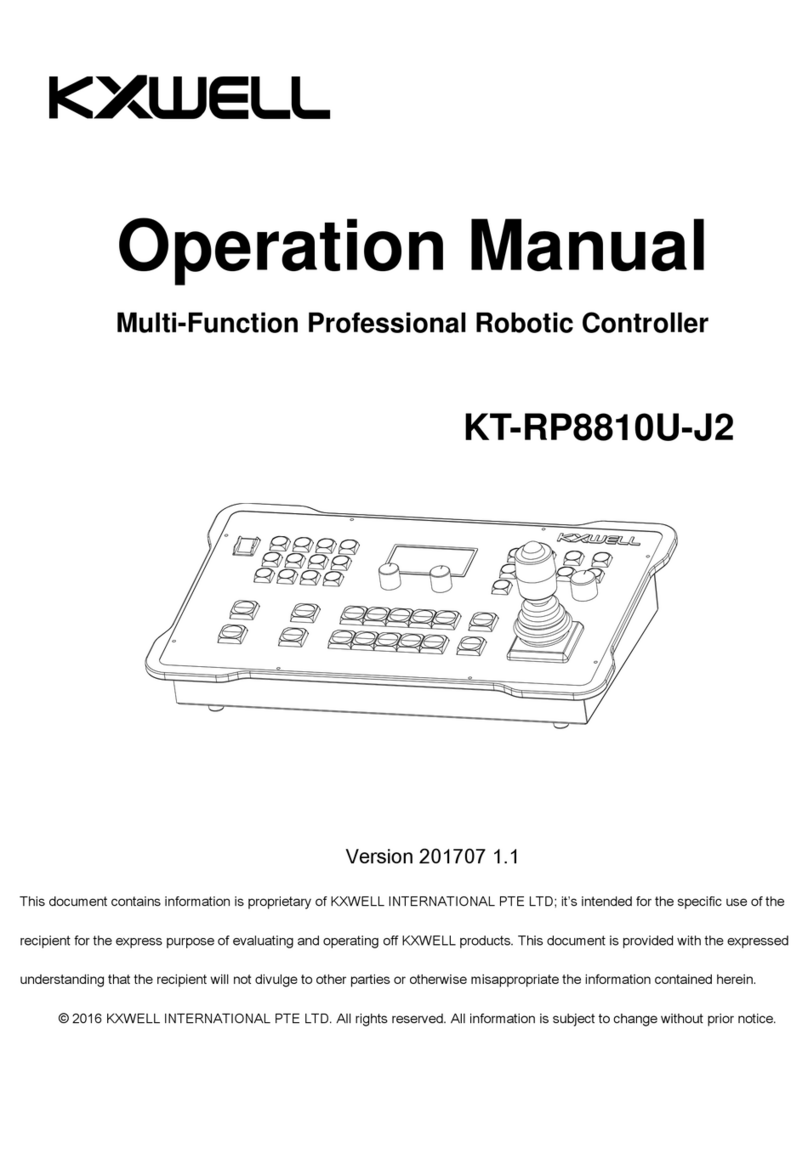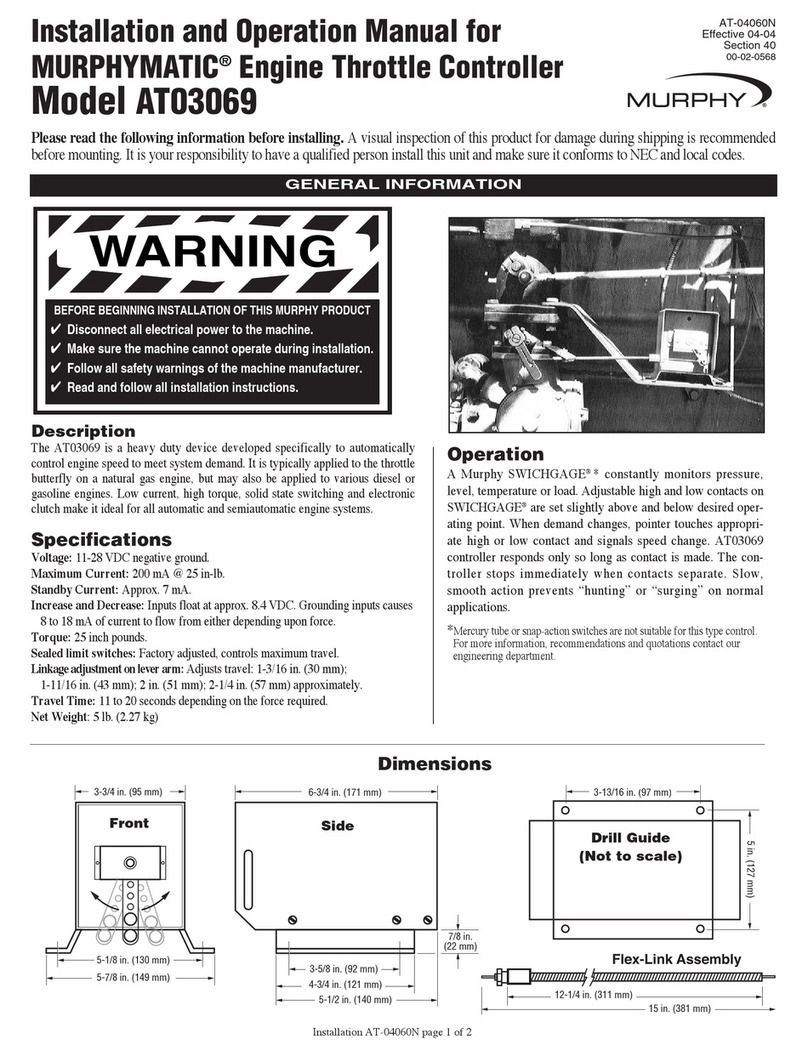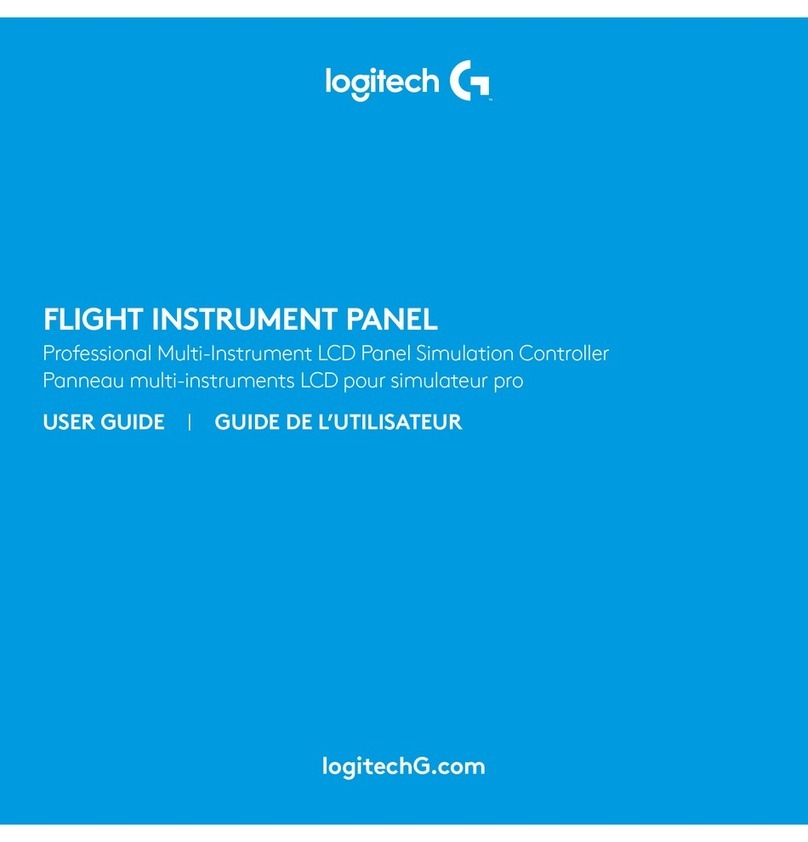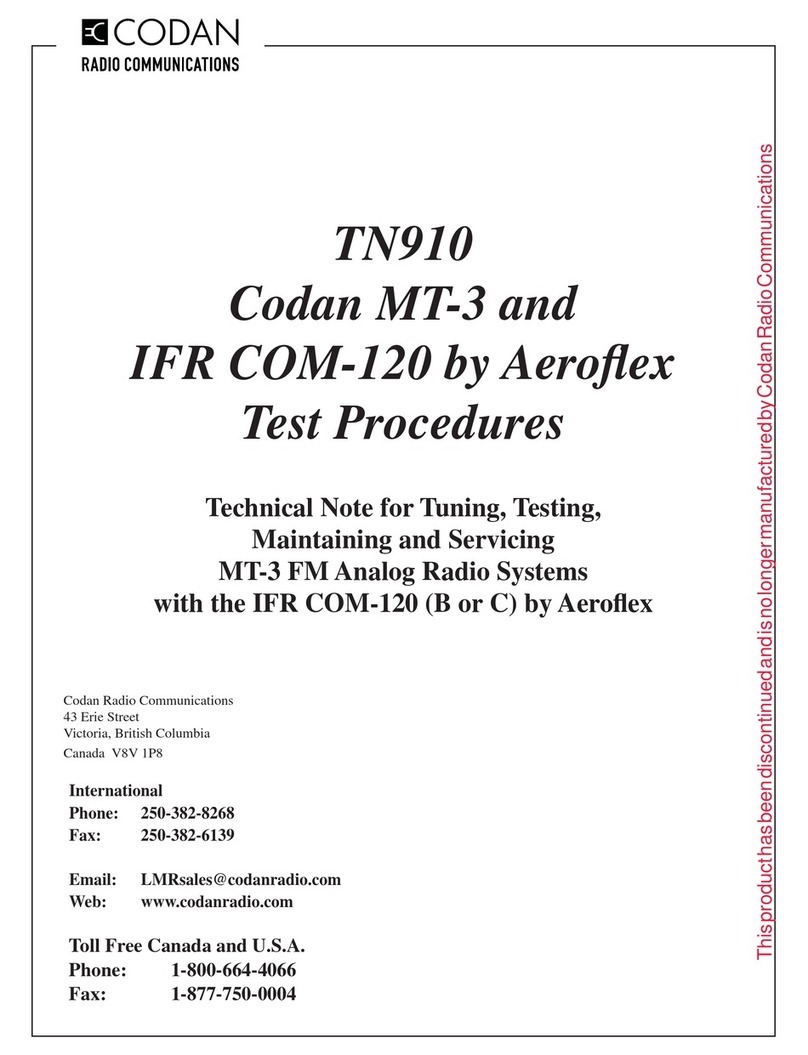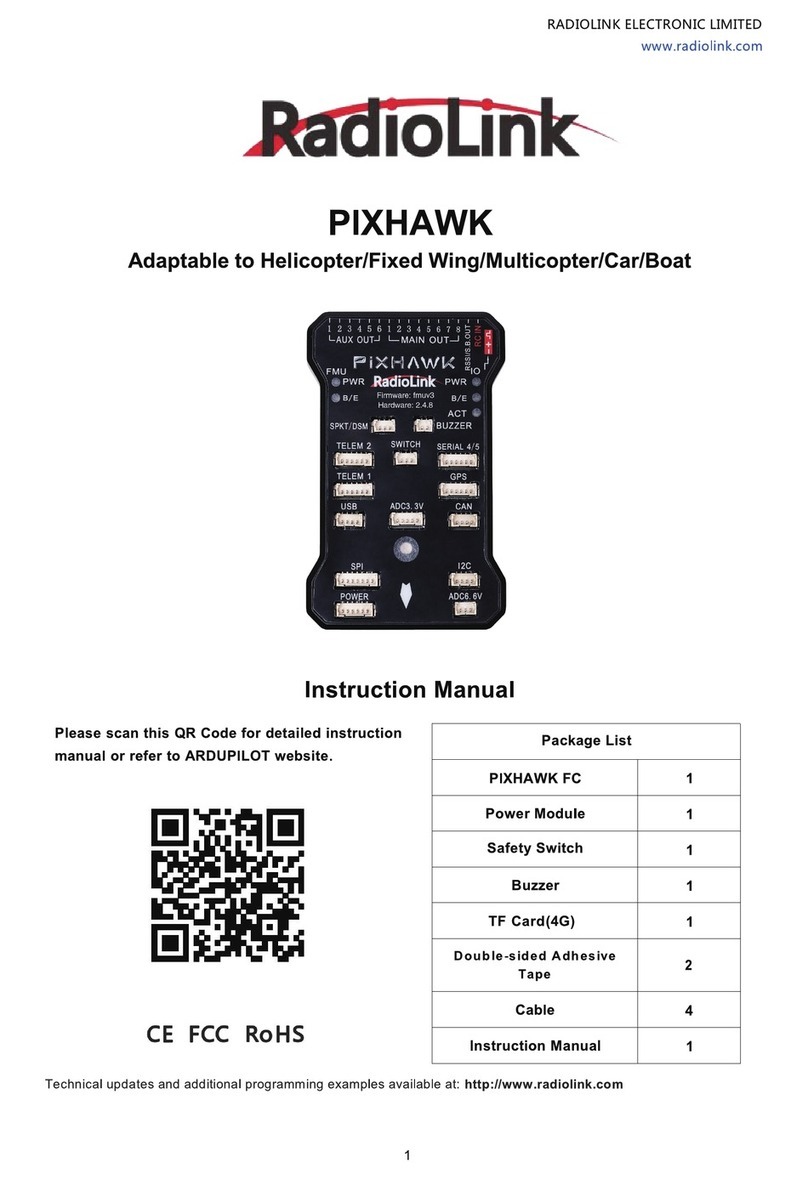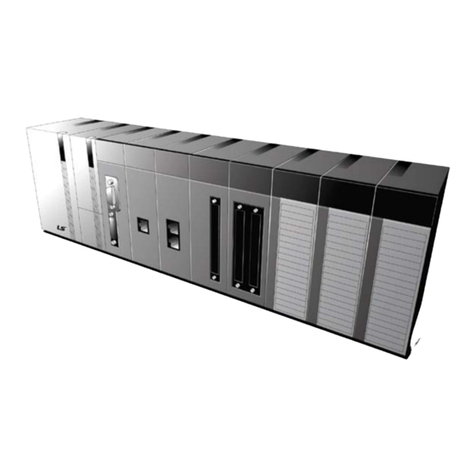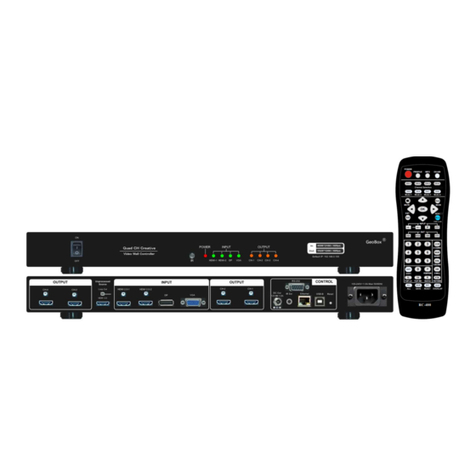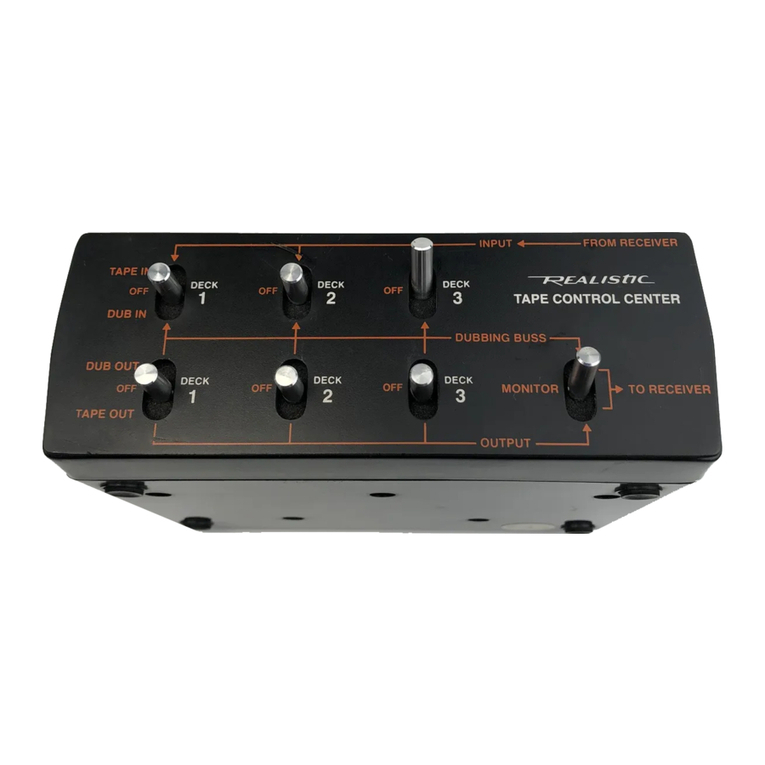Trace Engineering C40 User manual

C40
Charge-Diversion
& Load Controller
Introducing the C40
The C40 controller is the finest large-system
controller available. The C40 can be used with
12, 24, or 48-volt DC systems as a PV charge
controller, a DC diversion controller, or a DC
load controller (low voltage disconnect). These
capabilities make the C40 the only DC controller
you’ll need! Numerous standard features are
provided to maximize the performance of the
system:
Silent, solid-state Pulse Width Modulated
(PWM) charging process with three-stage
control, temperature compensation, and
manual or automatic equalization.
Maximizes system performance and
increases battery life.
Meets National Electrical Code (NEC) and
other international controller specifications.
Certified by ETL for the U.S. (UL Standard
1741 (draft), and Canada (CSA-C22.2 No.
14-M91 SEP 91)
Electronic overload and short circuit
protection with automatic and manual reset
capability increases the reliability of
unattended systems by eliminating blown
fuses and tripped circuit breakers
Field adjustment of charge setpoints is
provided by rotary controls with removable
knobs, reducing the potential for setpoint
tampering. Calibrated scales and test points
allow precise adjustments of settings
Optional external battery temperature compensation sensor (BTS) for automatic
adjustment of charge setpoints (required by UL draft standard 1741 and strongly
recommended for sealed batteries)
Over-temperature protection of the electronic circuitry (by reducing the charge rate)
improves the reliability of the C40 when used in environments over 113 F / 45 C.
Indoor-type, powder-coated enclosure for wall mounting
Multi-color status LED with matching color label for mode/status indication
Optional LCD meter for remote or direct mounting on the C40. May be mounted up to
1000 feet away
2 year limited warranty
!
!
!
!
!
!
!
!
!
!
!
°°
Introducing the C40
1
Copyright Trace Engineering Co. Inc. Tel (360) 435-8826 Part Number 2680 Rev. C
5916 195 Street, NE Fax (360) 435-2229 November 4, 1998
Arlington, WA 98223 USA www.traceengineering.com Page
th

IMPORTANT SAFETY INSTRUCTIONS
This manual contains important safety and operating instructions as prescribed by UL
standards for charge controllers used in photovoltaic applications. This manual covers
Trace Engineering model number C40 charge / load controller for use in residential and
commercial photovoltaic applications. The C40 has been certified by ETL to UL Standard
1741 (draft), Power Conditioning Units for use in Residential Photovoltaic Power Systems.
It is also approved to CSA standard CSA-22.2 No. 14-M91 SEP 91.
Before using the charge/load controller, read all instructions and cautionary markings on:
(1) the charge/load controller
(2) the batteries and
(3) the photovoltaic panels
CAUTION - To reduce risk of injury, charge only deep cycle lead-acid, lead-antimony, lead-
calcium, gel cell, absorbed mat, NiCad or NiFe type rechargeable batteries. Other types of
batteries may burst, causing personal injury and damage.
Do not attempt to repair the C40. Take it to a qualified service center when service or repair
is required. Incorrect re-assembly may result in a risk of electric shock or fire.
To reduce risk of electric shock, disconnect all wiring before attempting any maintenance or
cleaning. Turning off controls will not reduce this risk. Solar modules produce power when
exposed to light - cover them with opaque material before servicing.
WARNING - WORKING IN VICINITY OF A LEAD ACID BATTERY IS
DANGEROUS. BATTERIES GENERATE EXPLOSIVE GASES DURING
NORMAL OPERATION. Provide ventilation to outdoors from the highest
point of the battery compartment.
NEVER charge a frozen battery.
No terminals or lugs are required for hook-up of the DC wiring. Wiring should be rated for
75° C and should be no less than #8 AWG / 8.367mm2 gauge wire for use at 40 amps.
Terminals provided accept up to #2 AWG / 33.6 mm2 gauge stranded copper or aluminum
wire.
Insulate tool handles with tape to reduce the chance of a short circuit occurring. Spark or
short-circuits can cause an explosion.
Tools required to make DC wiring connections: Wire strippers, Phillips screwdriver #2,
Slotted screw driver 5/32" (4.5 mm).
This charge/load controller is intended to be used with a battery supply of 12, 24, or 48-
volts direct current nominal voltage..
For battery installation and maintenance, read the instructions provided with the batteries
prior to operating.
No DC disconnect switch is provided as an integral part of this unit. DC disconnects may
be required as part of the system installation. Refer to local electrical codes for
requirements.
No overcurrent protection for the battery supply is provided as an integral part of this unit.
General Precautions
SAVE THESE INSTRUCTIONS !
2
Copyright Trace Engineering Co. Inc. Tel (360) 435-8826 Part Number 2680 Rev. C
5916 195 Street, NE Fax (360) 435-2229 November 4, 1998
Arlington, WA 98223 USA www.traceengineering.com Page
th

Overcurrent protection for the battery cables must be provided as part of the system
installation. Refer to local electrical codes for requirements.
Although over current protection for the DC output wiring is provided as an integral part of
this unit, additional over current protection of the DC output wiring may be required as part
of the system installation. Refer to local electrical codes for requirements.
GROUNDING INSTRUCTIONS - This charge/load controller should be connected to a
grounded, metal, permanent wiring system. Connections to the grounding system should
comply with all local codes and ordinances.
Someone should be within range of your voice or close enough to come to your aid when
you work near batteries.
Have plenty of fresh water and soap nearby in case battery acid contacts skin, clothing, or
eyes.
Wear eye protection and protective clothing. Avoid touching eyes while working near
batteries.
If battery acid contacts skin or clothing, wash immediately with soap and water. If acid
enters an eye, immediately flood the eye with running cold water for at least 15 minutes and
get medical attention immediately.
Baking soda neutralizes spilled lead acid electrolyte. Vinegar neutralizes spilled NiCad
electrolyte. Keep a supply on hand.
NEVER smoke or allow a spark or flame in vicinity of a battery or generator.
Be extra cautious to reduce the possibility of dropping a metal tool onto
batteries, it might short-circuit batteries or other electrical parts that may
cause an explosion. Cover wrench handles with plastic tape or vinyl dip-
coating material.
Remove personal metal items such as rings, bracelets, necklaces, and
watches while installing the system. A single battery can produce a short-
circuit current high enough to weld a ring to a battery terminal, causing severe burns.
MicroSine miniture utility-interactive inverter fits on back of 24-volt PV solar module.
Allows you to ‘sell back’ power to the utility grid (not for charging batteries or UPS)
UX Series Inverters: affordable 600 to 1400 watts AC power from 12-volt DC source,
available with optional standby battery charger and remote control.
U2500 Series Inverters: 2200 to 2500 watts continuous AC power from 12, 24, 32, 36
or 48-volt DC source. Available with optional Standby charger for residential, RV, and
marine applications. Can be stacked. Optional remote available.
DR Series Inverter: 1500, 2400 or 3600 watt inverter features power-saving Search
Sense, quiet operation, stacking interface, and standard three-stage battery charger.
SW Series Inverter: True sine wave output to 230VAC from 12, 24, and 48-volt DC
sources. Stackable for up to 16.5 kilowatt, three-phase power with Search Sense,
Standby charger and multifunction LCD display; all standard equipment.
Power Module System: Complete power systems enclosed in corrosion-resistant,
powder-coated aluminum modules suitable for exterior installation. Modules can
include inverters, batteries, charge controllers, AC and DC breakers, and all associated
cabling and hardware. Factory or dealer pre-assembled.
Personal Precautions
Other Products from Trace Engineering:
!
!
!
!
!
!
Copyright Trace Engineering Co. Inc. Tel (360) 435-8826 Part Number 2680 Rev. C
5916 195 Street, NE Fax (360) 435-2229 November 4, 1998
Arlington, WA 98223 USA www.traceengineering.com Page
th
3

If the PV array’s output increases above the 40-amp level due to reflection or “edge of
cloud effect,” the C40 will continue to operate until the heatsink reaches a safe operating
temperature. This will take several minutes to occur depending upon the ambient
temperature involved. When the heatsink reaches the maximum safe temperature, the C40
will reduce the current, cooling the transistors and the heatsink. This will occur only if the
current flow exceeds the 40-amp level and the C40 is located in a very hot environment.
If the current from the PV array reaches 63 amps, the C40 will turn off to self protect. This
should never occur in a properly designed system. Ten minutes after shutting off to self
protect, the C40 will automatically restart.
The C40 charge controller rapidly cycles the current source on-and-off to control the
charging current and voltage of the battery. This occurs in both the charge control mode
and the diversion control mode. The amount of time the current source is connected to the
battery is varied to control the average current flow. This is often referred to as “pulse width
modulation” (PWM) and allows the current to be tapered, rather than coarsely turning the
current off and on as with relay type PV array charge controllers.
Each night the PV array is automatically disconnected from the battery to prevent reverse
leakage of power. This eliminates the need for a blocking diode between the battery and
the PV array. If thin-film or amorphous solar modules are being used, diodes may still be
required to prevent damage from partial shading conditions. Check the documentation
provided with the PV modules.
The C40 can operate as a 40-amp diversion control to manage battery charging from
alternative-energy sources such as wind or hydro-electric generators. Systems utilizing
solar arrays do not have a requirement for diversion loads since a solar module can be
open-circuited without damage. However, even with a solar based system it is desirable to
use excess power to operate DC loads. When used in this way, the C40 controls a
Automatic PV Array Night Disconnect
Diversion Control Mode
Operating Modes
The C40 controller can operate as either a photovoltaic charge controller, a diversion
controller, or a DC load controller. The C40 cannot operate as both a charge controller and
a DC load controller at the same time. If both are required in a system, two C40’s must be
installed. Use one C40 for each mode desired.
with three-stage regulation and automatic or manual
battery equalization cycle. When this mode is selected, the status LED will indicate either
blinking green or solid green. It will alternate red/green when in equalization mode.
for PV, hydro-electric, wind generator, or mixed source systems
with three-stage regulation and automatic or manual battery equalization cycle. When this
mode is selected the status LED will indicate either blinking green or solid green.
turns off the DC loads when battery voltage is low. When this
mode is selected, the status LED will typically indicate blinking red or solid red.
The C40 can regulate up to 40-amps of continuous photovoltaic (PV) array current at 12, 24
or 48-volt DC for charging batteries. This rating includes the NEC required deratings - it is
directly comparable to other controllers rated at 60 amps. When used in this mode, ensure
that the operating mode jumper is on the Charge Control pins. To enable the Photovoltaic
Charge Control Mode, see the section of this booklet.
Photovoltaic Charge Control Mode
Diversion Control Mode
DC Load Control Mode
Photovoltaic Charge Control Mode
User Configuration Options
4
Copyright Trace Engineering Co. Inc. Tel (360) 435-8826 Part Number 2680 Rev. C
5916 195 Street, NE Fax (360) 435-2229 November 4, 1998
Arlington, WA 98223 USA www.traceengineering.com Page
th
Pv ArrayPv Array Battery
C40
controller
C40
controller

5
diversion load to redirect the excess power generated instead of allowing it to flow into the
battery. This prevents damage to the charging source from an over-speed condition which
could occur if the charging source is suddenly disconnected from all loads - as series relay
regulators do. Consult your dealer for load and regulator size recommendations.
When the C40 operates as a diversion regulator, it provides three-stage regulation of
battery voltage, with temperature compensation and automatic or manual equalization.
See the section for more information on this process.
Diversion mode requires a separate load “dump” to regulate the battery. This load must be
able to absorb more power than the charging source is able to produce at its peak output,
or the DC voltage will become unregulated. The dump load must be available for the
diversion of power at all times. Resistive-type heating elements are the best diversion
loads. Special direct current water heating elements are available. Light bulbs and motors
are not recommended as diversion loads because they are unreliable.
When used in diversion mode, ensure that the operating mode jumpers are on the charge
control pins. See the section of this booklet.
Current draw of the diversion load is very important. Problems may arise from operating
with a load that is too small or too large. A diversion load that is too small will not be able to
absorb all the excess power from the current source once the batteries are full.
Diversion loads in excess of 63 amps are capable of absorbing more power than the C40 is
designed to handle, resulting in an over-current shut down. During this time, the unit will
not regulate electrical flow in the system, and battery damage may result.
A diversion load that draws about 50 amps when connected to the battery is usually
suitable for use with the C40. The load should be sized about 25% larger than the charging
source’s maximum output capability.
The C40 can also operate as a 40-amp load control (also called a low voltage disconnect)
to manage the discharging of the battery. A load controller prevents damage to the battery
from over-discharge during periods of poor weather or excessive loads.
When used in load control mode, ensure that the operating mode jumpers are on the load
control pins. See section of this booklet.
The controller delays disconnecting the DC loads for 10 minutes after the voltage drops
below the low voltage disconnect (LVD) setting. Loads are either automatically or manually
reconnected when battery voltage exceeds the low-voltage reconnect (LVR) setting for 10
minutes. The EQUALIZE jumper determines manual or automatic reconnect when the C40
is used as a load controller.
When used as a DC load controller, the settings of the
LVR and LVD are controlled by two rotary knobs on the
circuit board. The scale on the adjustment pots differ
from the scale used for other functions. A decal with
the corrected adjustment scale is included with the C40
and shown at right. Place this scale over the pots
when using the C40 as a load controller. Do not
temperature-compensate these settings. Do not install
the optional battery temperature compensation sensor.
Three-stage Battery Charging
User Configuration Options
Configuring the C40
DC Load Control Mode
Copyright Trace Engineering Co. Inc. Tel (360) 435-8826 Part Number 2680 Rev. C
5916 195 Street, NE Fax (360) 435-2229 November 4, 1998
Arlington, WA 98223 USA www.traceengineering.com Page
th
DC LOADDC LOAD
Battery C40
controller
C40
controller
Battery C40
controller
C40
controller
Diversion
‘dump’ load
Diversion
‘dump’ load
PV, HYDRO,
or WIND
PV, HYDRO,
or WIND

6
Features
The C40 features include over-temperature protection, electronic over-current protection,
and automatic battery temperature compensation.
The temperature of the C40’s transistors are continuously monitored. This protects the
charge controller from damage in high temperature environments. If excessive
temperatures are detected while operating in charge or diversion control mode, the C40’s
transistors are rapidly turned off and on to reduce the charge rate. This will reduce the
transistor temperature.
As a load controller, the load is disconnected before the transistors reach an excessive
temperature. Once the temperature has dropped, the loads are reconnected.
When the over temperature protection system has caused the C40 to shutdown, the status
LED will be orange and will blink fast (about once a second). This is the same indication
shown during an overcurrent condition.
During operation, the C40 continuously monitors the current flowing through it. If the current
exceeds 63 amps, the transistor switches are opened, stopping the flow of electricity. This
protects the loads and array wiring from short circuits and overloads. The detection
circuitry is faster than breakers or fuses, and they will not trip or blow when a fault occurs.
When the overcurrent protection system is activated, the status LED will indicate orange
and will blink fast (about once a second). This is the same indication as produced by an
over temperature condition.
The C40 automatically resets the overcurrent protection system every 10 minutes. If an
overload or short circuit is still present, the C40 will shut off and wait another 10 minutes.
This will occur continuously until the problem is corrected.
The reset switch on the right side of the C40 allows the user to manually reconnect the PV
array or DC loads after an overcurrent condition occurs. Hold the reset switch for 5
seconds to return to normal operation. If the C40 is unable to restart, check the wiring and
reduce the loads connected. There may be a delay after manually pressing the reset
switch before reconnecting the PV array.
The shunt used to measure the current flow in the C40 is located in the positive conductor
of the circuit as required by UL Standard 1741 (draft). The negative terminals are all
common to one another.
The optional plug-in external battery temperature sensor (BTS) automatically fine tunes the
charging process of the C40. The BTS is required by UL Standard 1741(draft). ETL
approval is based on its installation. However, do not install the battery temperature sensor
if you are using the C40 as a DC load controller. The BTS may be extended by using a
standard phone cable with RJ-11 plugs.
If the temperature sensor is installed, the regulation setpoints should be adjusted for a
battery at room temperature (23 -27°C/74 -80°F). The C40 adjusts the BULK and FLOAT
setpoints -5mV per degree Celsius for a 6-cell, lead-acid type battery and -2mV per degree
Celsius for a 10-cell, NiCad type battery as required per UL Standard 1741. If the
temperature sensor is NOT installed, the setpoints should be adjusted for the temperature
of the battery during operation. Seasonal adjustment of the setpoints may be necessary to
prevent battery damage and to ensure proper charging. If the battery temperature sensor
is installed, no seasonal adjustments are required (see Temperature Compensation in this
manual).
If the wiring to the sensor is damaged and the wires are shorted or cut, the system will
return to the non-temperature compensated settings.
Over Temperature Protection
Electronic Overcurrent Protection
Battery Temperature Compensation
Copyright Trace Engineering Co. Inc. Tel (360) 435-8826 Part Number 2680 Rev. C
5916 195 Street, NE Fax (360) 435-2229 November 4, 1998
Arlington, WA 98223 USA www.traceengineering.com Page
th

Install the BTS on the side of the battery below the
electrolyte level. It is best to place the
sensor between batteries and place the batteries in an
insulated box to reduce the influence of the ambient
temperature outside the battery enclosure. Ventilate the
battery box at the highest point to prevent hydrogen
accumulation.
A multi-color LED indicator is provided to indicate the
operating status of the C40. A color-coded label is included
on the cover of the C40 to explain the status LED’s
operation. When the C40 is in Charge Control or Load
Diversion mode, the LED will be green. When in Load
Control mode, the LED will be red. An orange LED indicates an error condition. When
battery equalization is in process, the LED will alternate between red and green.
- The battery has entered the FLOAT stage of the charging process. The
status LED will remain solid unless the batteries drop below the Float voltage setting for an
accumulative period of one hour. This allows the user to confirm that the system reached
FLOAT during the charging process when checked at the end of the day. Reaching the
FLOAT stage frequently is a good indication of proper system operation and will maximize
battery life and performance.
- indicates that the controller is in the Charge Control or Diversion Control
mode and the battery is not fully charged. As the battery voltage approaches the Bulk
setting, the status LED will blink green several times (up to 5) and then pause. This
indicates that the battery voltage is approaching the Bulk setting and provides an indication
of the battery condition.
LED STATUS Indicator
Charge Control or Diversion Control Mode Indications
Solid Green
Blinking Green
Copyright Trace Engineering Co. Inc. Tel (360) 435-8826 Part Number 2680 Rev. C
5916 195 Street, NE Fax (360) 435-2229 November 4, 1998
Arlington, WA 98223 USA www.traceengineering.com Page
th
Green =Charge Control Mode or
Diversion Control Mode
When flashing, battery voltage =
HVD(bulk) setting minus value
shown.
Single green flash = voltage below
lowest HVD setting. See table.
Red = Load Control Mode
When flashing, battery
voltage = LVD setting plus value
shown on table.
Single Red flash = low voltage
Orange = Slow Flash = Low
Voltage
Fast Flash = Error Condition
Red/Green
Equalization in Process
Alternating =
(DVM/C40)
HVD SETTINGHVD SETTING
BATTERY FULL
RESET AMP-HOURS
LVD SETTINGLVD SETTING
REVERSE POLARITYREVERSE POLARITY
0.15V 0.30V 0.45V0.15V 0.30V 0.45V
BATTERY EMPTY
12.60 / 25.20 / 50.4012.60 / 25.20 / 50.40
0.45V 0.90V 1.35V0.45V 0.90V 1.35V
0.30V 0.60V 0.90V0.30V 0.60V 0.90V
CONNECTION OF THE BATTERY OR PV ARRAYCONNECTION OF THE BATTERY OR PV ARRAY
WILL SOUND AN INTERNAL BUZZER. FAILUREWILL SOUND AN INTERNAL BUZZER. FAILURE
TO CORRECT THIS CONDITION WILL RESULTTO CORRECT THIS CONDITION WILL RESULT
No 14-M91 SEP 91No 14-M91 SEP 91
IN DAMAGE TO THE CONTROLLER.IN DAMAGE TO THE CONTROLLER.
INDUSTRIAL POWER
COMMERCIAL AND
SUPPLIES
POWER CONDITIONINGPOWER CONDITIONING
POWER SYSTEMSPOWER SYSTEMS
PHOTOVOLTAIC
RESIDENTIAL
UNITS FOR USE INUNITS FOR USE IN
UL DRAFT 1741
CSA-C22.2 LVD
LVD
LVD
12.0V
HVD
HVD
HVD
0.50V
0.75V
12.0V
0.25V
STATUS LEDSTATUS LED
INDICATOR
AMP HOUR METERAMP HOUR METER
PN 2247PN 2247
TO RESET THETO RESET THE
PUSH AND HOLDPUSH AND HOLD
FOR 10 SECONDSFOR 10 SECONDS
LOW VOLTAGELOW VOLTAGE
DISCONNECT
EQUALIZE ACTIVATED
OVER CURRENTOVER CURRENT
OVER TEMPERATURE
OR
E F
START / STOP EQUALIZATION MODESTART / STOP EQUALIZATION MODE
HOLD RESET IN FOR 10 SECONDS TO INITIATEHOLD RESET IN FOR 10 SECONDS TO INITIATE
EQUALIZATION CYCLE. PUSH ONCE TO ABORTEQUALIZATION CYCLE. PUSH ONCE TO ABORT
48.0V24.0V
1.00V
48.0V
2.00V
3.00V
1.00V
1.50V
24.0V
0.50V
FE
FE
CURRENT
AMP-HOURS
RESETTABLE
ARRAY/LOAD
TOTALIZING
AMP-HOURS
VOLTAGE
BATTERY
WARNING !!!WARNING !!!
(UP TO 1 MINUTE DELAY WHEN(UP TO 1 MINUTE DELAY WHEN
PUSHED - 10 MIN AUTO RESET)PUSHED - 10 MIN AUTO RESET)
10 MINUTES OF LOAD OPERATION AFTER LVD.10 MINUTES OF LOAD OPERATION AFTER LVD.
ONE PUSH WILL GIVEONE PUSH WILL GIVE
RECONNECT LOAD
RESET OVERLOAD
SOLID REDSOLID RED
SOLID GREENSOLID GREEN
C40
40 Amp 3 Stage Solar Charge Controller40 Amp 3 Stage Solar Charge Controller
40 Amp DC Load Controller40 Amp DC Load Controller
OR
7

Load Control Indications
Equalization Mode Indication
Error Mode Indication
Mounting
Solid Red -
Blinking Red
Alternating Red and Green -
Caution: It is in your best interests to install the C40 in a dry, protected location away
from sources of high temperature, moisture, and vibration. Exposure to saltwater is
particularly destructive. Corrosion of the circuit board is not covered by the
warranty. If you wouldn’t put your television there, don’t put the C40 there.
indicates that the controller is in the DC Load Control mode and the battery
voltage has reached the Low Voltage Disconnect (LVD) setting. After a 10 minute delay,
DC loads will be disconnected unless the user reduces the loads to a point that the battery
voltage exceeds the LVD setting.
- As battery voltage approaches the LVD setting, the LED will blink red
several times (up to 5) and then pause. This provides an indication of battery condition.
Slow Blinking Orange - indicates that the C40 is in the DC Load Control mode and has
disconnected the loads due to reaching the LVD setting. The user can press the reset
switch for a maximum10 minute “grace” period, or can wait until the voltage rises above the
Low Voltage Reconnect (LVR) setting to allow an automatic reset to occur.
indicates that the C40 is in equalize mode. It will
automatically stop the equalization process after accumulating two hours of operation at a
voltage above the BULK setting. The user can stop the equalization process at any time by
pressing the reset switch until the status LED stops alternating red and green.
Fast Blinking Orange - indicates that the C40 has detected a short circuit or an over-
temperature condition and has disconnected the loads. The C40 will try to automatically
restart the loads after a 10 minute delay. If the C40 will not restart, turn off all loads and
press the reset switch. If the C40 then restarts, the loads may be too large. A delay up to
five seconds may occur before the C40 attempts to restart after pressing the reset switch.
The C40 controller is a state-of-the-art precision electronic instrument. Installation,
environment, mounting, and wiring must be accomplished in accordance with applicable
local and national electrical codes. The instructions that follow are applicable to the typical
installation. For special applications, consult a qualified electrician or your Trace dealer.
Installation procedures will vary according to your specific application.
The C40 is designed for indoor mounting. Care should be taken in selecting a location and
when mounting the enclosure. Avoid mounting the C40 in direct sunlight in order to reduce
heating of the enclosure and subsequent high operating temperatures. The enclosure
should be mounted vertically on a wall.
Mounting and enclosure dimensions are shown in the adjacent diagram. Remove the
faceplate on the C40 and locate the upper two screw locations on the wall. The back of the
enclosure is provided with key-holes for mounting. Leave the screw heads backed out
approximately 1/4 inch (6 mm). Place the C40 onto the screws and pull it down into the
keyhole slots. Then insert the two lower screws to lock the enclosure onto the wall.
Provide either strain-relief clamps or conduit to prevent damage to the circuit board and
terminal block from pulling on the wires. The cover should be replaced and retained with
the screws provided (#10-32 x 3/8” SMS).
In severe environments, additional consideration should be taken to minimize exposure to
wet environments. The use of conformal-coated circuit boards, plated terminals, powder
coated metal components, and stainless steel fasteners improves tolerance to hostile
environments.
Installation
8
Copyright Trace Engineering Co. Inc. Tel (360) 435-8826 Part Number 2680 Rev. C
5916 195 Street, NE Fax (360) 435-2229 November 4, 1998
Arlington, WA 98223 USA www.traceengineering.com Page
th

Do not locate the C40 in a sealed compartment with the batteries. Batteries can generate
hydrogen sulfide gas which is very corrosive to electronic equipment and everything else.
They also generate hydrogen and oxygen. If accumulated, this mixture could be ignited by
an arc caused by the connection of battery cables, a loose terminal, etc. Installation within
a ventilated enclosure with sealed batteries only is acceptable.
Be sure to set the voltage selector jumper to the appropriate setting before energizing the
system (see for instructions). Incorrect settings may result in
damage to the system as the charging regulation will not occur. Torque the terminals to
25 inch-pounds once the wires have been installed. Replace the cover after wiring.
The minimum recommended wire gauge is 8 AWG (13.3 mm2) with a 75° C insulation
rating. The terminals on the C40 will accept up to #2 AWG (33.6mm2) copper or aluminum
wire. No crimp-on terminals or lugs are required. The following table gives the maximum
permissible length allowed for each wire size at 40 amps with 3% voltage drop. Find your
Wiring
User Configuration Options
NOTE: Regardless of configuration, only the positive conductor from a PV array or
a DC load may be connected to the terminal marked “PV POS/LOAD.”
Copyright Trace Engineering Co. Inc. Tel (360) 435-8826 Part Number 2680 Rev. C
5916 195 Street, NE Fax (360) 435-2229 November 4, 1998
Arlington, WA 98223 USA www.traceengineering.com Page
th
PV+/WIND+/LOAD+
Warning: Due to a printing error (what were we thinking?), the input
terminal on the C40 Rev. #2230D printed circuit board is incorrectly
labeled ‘PV+/WIND+/LOAD+.’ Never connect a wind generator to this
terminal. Rev.#2230D is not designed to accept the very large current
fluctuations typical of wind generators. Damage to the C40 will result.
Warning: Due to a printing error (what were we thinking?), the input
terminal on the C40 Rev. #2230D printed circuit board is incorrectly
labeled ‘PV+/WIND+/LOAD+.’ Never connect a wind generator to this
terminal. Rev.#2230D is not designed to accept the very large current
fluctuations typical of wind generators. Damage to the C40 will result.
9

10
system voltage in the left column, and the distance from your power source (feet/meters) to
the C40 (or the distance from the C40 to your load) on the same line, then read the wire
size required at the top of the column. Don’t use wire smaller than #8 gauge.
The wiring, overcurrent protection devices (fuses and circuit breakers) and installation
methods used must conform to all local electrical codes requirements.
Wiring should be protected from physical damage with conduit or a strain relief clamp. You
should pull the temperature sensor cable through the conduit first as the connector may not
fit if other wires have been pulled first.
As a minimum, a 60-amp DC rated current limiting fuse in an appropriate fuse holder or
disconnect switch should be provided near the battery for protection from short circuits.
Local electrical codes should be consulted for wire sizing and any additional installation
requirements. The use of breakers or fuses above 60 amps is not recommended. Use
Trace part number CD60DC available from your Trace dealer.
Photovoltaic arrays generate current whenever light strikes the surface of the array. Before
connecting the C40, cover the array to prevent any current from being generated. Remove
one or more of the knockout plugs on the C40’s case and feed the connecting wires
through it. Connect the PV array’s positive output to the terminal marked PV POS/LOAD at
the bottom of C40’s circuit board. Connect the negative output to the terminal marked PV
NEG. Tighten the lugs to 12 ft/lbs (17.86 Kg/m)
Connect the battery positive cable to the terminal marked BAT POS on the bottom of the
C40’s circuit board. Connect the negative battery cable to the terminal marked BAT NEG
on the C40’s circuit board. Secure the cabling with strain reliefs after allowing a little slack
inside the case to prevent damage to the C40’s circuit board.
When using the C40 as a diversion or DC load controller, the DC load needs to be
connected to the terminals marked as PV POS/LOAD and PV NEG on the C40. The two
negative terminals are common and can be reversed or wired with a single conductor to a
more convenient location such as a DC load center negative bus.
Connect your DC current source (PV, wind, hydro, etc.) directly to a battery, then connect
an appropriately-sized cable from the positive battery terminal to the C40 terminal marked
BAT POS. Connect a cable from the negative battery terminal to the terminal marked BAT
NEG on the C40’s circuit board. Connect a cable from the C40’s terminal marked PV
POS/LOAD to the positive terminal of your DC Diversion load. Connect a cable from the
terminal marked PV NEG on the C40 to the negative terminal of your DC Diversion load.
Tighten the terminal lugs to 12 ft/lbs (17.86 Kg/m). Allow a little slack on the cables within
the C40 and secure the wiring with strain reliefs.
PV Charge Control Mode Cabling
Diversion Control Mode Cabling
Copyright Trace Engineering Co. Inc. Tel (360) 435-8826 Part Number 2680 Rev. C
5916 195 Street, NE Fax (360) 435-2229 November 4, 1998
Arlington, WA 98223 USA www.traceengineering.com Page
th
C40
VOLTAGE
12vdc
24vdc
48vdc
8AWG
5.6/1.7m
11.1/3.38m
22.2/6.77m
6AWG
8.8/2.68m
17.6/5.36m
35.2/10.72m
4AWG
14/4.26m
28/8.53m
56/17.06m
3AWG
17.7/5.38m
35.4/10.79m
70.8/21.58m
2AWG
22.4/6.83m
44.8/13.66m
89.6/27.31m
Maximum One-Way Wire Distance in Feet/Meters
(40 Amps with 3% Voltage Drop)

DC Load Control Mode Cabling
Connect the positive battery cable to the terminal marked BAT POS on the C40 PCB, and
the negative battery cable to the terminal marked BAT NEG when using the C40 a load
controller. Connect a cable between the PV POS/LOAD terminal on the C40 and the
positive terminal on the DC load. Connect a cable between the PV/NEG terminal on the
C40 to the negative terminal of the load.
The C40 is designed to work with both negative ground and ungrounded electrical systems.
The metal chassis of this charge/load controller must be grounded for either system by
connecting it with a copper wire to a grounding electrode such as a ground rod driven into
the earth. If a negative ground system is desired, connect the negative current carrying
conductor to the grounding system at one point in the system. Consult local electrical
codes for more information and any additional requirements.
Located on the right side of the C40’s circuit board are three jumpers. It is mandatory that
these jumpers be set correctly for the unit to operate to it’s maximum potential.
A jumper is a small, rectangular piece of plastic with two square
holes in it that fits over two pins as shown in the illustration at
left. A jumper contains an internal conductor that joins the two
pins, completing a circuit. When the jumper is removed, the
circuit is interrupted. Jumpers are often used for changing
configuration parameters. When a jumper is not connecting two
pins, it can be stored by slipping it over just one of the pins
instead of both. This will have no effect upon the configuration,
but will keep the jumper handy for future use.
The C40 is equipped with several of these jumpers. They control equalization, low voltage
reconnect, battery voltage, and operating modes. Each of these are discussed in the
appropriate section of this manual. The factory default settings are shown below:
Enables automatic or manual battery equalization in Charge Control mode, and automatic
or manual reconnect in the event of low voltage at the BAT POS terminal in Load Control
mode. When AUTO is enabled In Load Control mode, the unit will reconnect automatically
when voltage at the BAT POS terminal exceeds the LVR setting. Factory setting is
manual equalization and manual reconnect.
- This jumper determines the operating mode: PV Charge Control and
Diversion Control mode, or Load Control model. Factory setting is Charge Control mode.
- Press and hold to manually initiate or suspend battery equalization in
Charge Control mode. Press and release to reset following an error condition. Press and
release to reconnect following a low-voltage disconnect event. If voltage remains below the
LVD setting, the unit will disconnect after a 10-minute ‘grace’ period.
- This jumper determines the voltage of the system that the C40 will be working
with. Connect the two pins adjacent to the legend for the voltage of your system: 12, 24,
48. Factory setting is 48-volts. The maximum DC voltage allowed is 90VDC for a 48-volt
system, 50VDC for a 24-volt system, and 25VDC for a 12-volt system.
If the optional digital volt meter (DVM/C40 or C40R) is attached to the C40, be sure to set
the jumper on the back of it for the appropriate system voltage. The jumper for limiting
power consumption and dimming the DVM display is also located on the back of the DVM.
Grounding
Configuring the C40
Battery Voltage: 48 volts DC
Equalize/LVR: manual Equalization
Operating Mode: Charge Control
Automatic/Manual Battery Equalization (EQ) and Low Voltage Reconnect (LVR)
Operating Mode
Reset Switch
Voltage
11
Copyright Trace Engineering Co. Inc. Tel (360) 435-8826 Part Number 2680 Rev. C
5916 195 Street, NE Fax (360) 435-2229 November 4, 1998
Arlington, WA 98223 USA www.traceengineering.com Page
th
Jumper
On
Off
Pins

12
Adjusting the C40
The charge voltage and 0reconnect/disconnect voltage setting of the C40
are adjustable via two rotary potentiometer controls. The knobs are
removable to reduce the likeliness of tampering with the settings.
Calibrated scales are provided to allow setting of the control without
requiring the use of a digital voltmeter. Visual adjustment allows an
accuracy of +/- 0.1 volts.
In Charge Control mode or Diversion Control mode, you can adjust the
Bulk and Float charging voltage by adjusting the potentiometers (pots)
located in the bottom center of the C40 circuit board (for more
information regarding Bulk and Float settings, see the Three Stage Battery
Charging Process section of this manual).
The pot scale for Bulk charge voltage is calibrated from 13.0 to 15.0 volts
(when the voltage jumper is set for a 12-volt system) in increments of 0.2
volts, from 26.0 to 30.0 volts (24-volt system) in increments of 0.4 volts, or
from 52.0 to 60.0 volts (48-volt system) in increments of 0.8 volts. For
Float charge voltage, the pot scale is calibrated from 12.5 to 14.5 volts (12-
volt system), 25.0 to 29.0 volts (24-volt system), and from 50.0 to 58.0
volts (48-volt system) with the same increments as above.
At midrange on these scales, a test point is provided for use with a volt meter for assuring
more accurate adjustment. The pots are equipped with removable knobs, to prevent
accidental adjustments by the curious or uninformed. If the knobs are missing, a 5/64” hex-
head driver can be used to adjust the settings. A digital volt meter can be connected from
the BAT NEG terminal on the circuit board and the small testpoint located to the left of each
adjustment pot at the 9 o’clock position. The testpoint provides a reading from zero to two
volts - this value must be added to the lower value of the adjustment range (Bulk=13.0,
Float=12.5, LVR=12.0, LVD=10.5). Multiply this value by 2 for 24 V and by 4 for 48 V.
For example, to set the BULK (HVD) voltage to 14.4 volts, adjust the pot until the testpoint
reads 1.4 volts (13.0 V + 1.4 V = 14.4 V) or to set to 28.2, adjust the pot until the testpoint
reads 1.10 volts [1.10x2(24V)=22+26.0 = 28.2].
Remember to add two volts to the settings when using NiCad type batteries.
Setting Voltage Parameters
Testpoints for Voltage Settings
Copyright Trace Engineering Co. Inc. Tel (360) 435-8826 Part Number 2680 Rev. C
5916 195 Street, NE Fax (360) 435-2229 November 4, 1998
Arlington, WA 98223 USA www.traceengineering.com Page
th
BAT NEG
Press reset for 10 seconds
to initiate reset cycle; press
and release to abort
Potentiometer
Test Points
DVM or Remote
Connection
BTS Connection
BATTERY POSITIVE+ PV NEGPV NEG
GROUND
METER
Torque: 25 IN LBTorque: 25 IN LB
PV POS/LOADPV POS/LOAD
/LVR

13
If you are using the C40 as a DC load controller, be sure to set the pots as shown in the
section of this manual. The upper knobs settings are reduced by one volt,
resulting in a range of 14.0 to 12.0 VDC (for a 12 volt system). The lower knobs settings
are reduced by two volts, resulting a range of 12.5 to 10.5 VDC (for a 12 volt system).
The C40 offers either manual or automatic triggering of the equalization process (the
default setting is manual). Automatic equalization is enabled by moving the jumper located
on right side of the circuit board above the reset switch. When automatic has been
selected, an equalization charge (holding the voltage one volt (for 12 volt systems) above
the BULK setting for 2 hours) will occur every 30 days. During the equalization process the
status LED will indicate equalization by alternately blinking green and red. (Equalization is
not recommended for NiCad batteries and is disabled when the R46 resistor is cut - see the
drawing for location.)
Manual equalization of the battery can be enabled by pressing the reset
switch on the right side of the C40 for 10 seconds. The status LED
indicator will begin to alternate between red and green once equalization is
enabled. The equalization process will continue until the batteries have
been held at or above the BULK setting for two hours of accumulated time.
During the equalization process, the battery voltage will be limited to one
volt above the BULK setting for 12 volt systems (for 24V systems, 2 volts
and 48V systems, 4 volts above BULK). Once the battery voltage has
been at or above the BULK setting for a cumulative period of two hours, the C40 will
return to the FLOAT stage of the charging process.
To stop the equalization process, press the reset switch. The status LED will stop
alternating between red and green. If the equalization process was shorter than one hour,
the C40 will continue with a BULK charge cycle and then hold the battery at the BULK
setting for one hour (the absorption stage) before returning to the FLOAT setting.
During the equalization process the status LED will alternate between red and green and
will not provide any other mode/status indication. Large battery banks may need several
equalization cycles to fully stir the electrolyte and charge the cells. These cycles should
follow one another until the battery voltage reaches the upper limit for the full two hours.
The C40 can automatically trigger an equalization charge every 30 days. The status LED
will indicate that the equalization process is occurring. The equalization process will
continue until the voltage has been held above the BULK setting for a cumulative period of
two hours. This might take several days on larger systems with big batteries and small PV
arrays. The battery voltage only needs to exceed the BULK setting for the timer to start
counting - the voltage may not reach the equalization voltage limiting setting of one volt
above the BULK setting (for a 12 volt system).
To enable automatic equalization, the jumper located on the right
side of the circuit board must be moved to the AUTO setting. The
default setting of the C40 is for manual equalization. To
permanently disable the automatic equalization system, remove
the equalize jumper.
To manually stop the equalization process, press the reset switch
at the right side of the C40 until the status LED stops alternating
between red and green. If the equalization process was shorter than one hour, the C40 will
continue with a BULK charge cycle and then hold the battery at the BULK setting for one
hour (the absorption stage) before returning to the FLOAT setting.
Once a manual equalization has been triggered, the 30-day period to the next automatic
equalization will be restarted. To prevent automatic equalization, move the equalize jumper
to the manual position.
DC
Load Control
Equalization
Manual Equalization
Automatic Equalization
Copyright Trace Engineering Co. Inc. Tel (360) 435-8826 Part Number 2680 Rev. C
5916 195 Street, NE Fax (360) 435-2229 November 4, 1998
Arlington, WA 98223 USA www.traceengineering.com Page
th
/LVR

14
Temperature Compensation
Setting LVR and LVD (Load Control Mode)
Setting HVD (Diversion Control Mode)
If a temperature compensation sensor is installed, the charge or diversion control process
will be automatically adjusted for the battery temperature. Set BULK and FLOAT voltage
for a battery at normal room temperature (23 -27°C/74 -80°F). Actual voltage may vary
above or below these settings due to adjustment for battery temperature.
If no temperature compensation sensor is installed and the batteries will be operating in
very hot or very cold conditions, adjust the BULK and FLOAT settings to allow for the
battery temperature. The recommended adjustments can be found in the table below. The
setting should be lowered for ambiant temperatures above 80 F/27 C and raised for
ambiant temperature below 75 F/23 C. If significant seasonal variations are common, you
will have to change the settings several times a year to prevent battery damage and ensure
proper operation.
Do not compensate the settings when using the C40 as a DC Load Controller.
You can change the low voltage disconnect (LVD) and low voltage reconnect (LVR) settings
using the same potentiometers described above. When the C40 is in DC Load Control
mode, the pots scale calibration is altered. For 12-volt application subtract two volts from
the scale shown on the circuit board for the LVR setting (Bulk setting when in Charge
Control mode) and subtract two volts from the scale shown for the LVD setting (Float setting
in Charge Control mode). Subtract four volts for a 24-volt application, and eight volts for a
48-volt application . The C40 comes with a two-part decal
that can be placed over the pots (after removing the
knobs) that shows the correct scales for DC Load Control
mode. The decal can be found inside the C40 chassis at
the bottom.
MANUAL reconnect of the loads is allowed if voltage has
not exceeded the LVR setting. To reconnect the loads,
press the reset button on the right side of the C40. If the
voltage is below the LVR level, the DC load can be
reconnected for an approximately 10 minute “grace”
period. Multiple “grace” periods are allowed, but the
duration of the ‘grace’ period will vary with battery voltage. The EQUALIZE jumper allows
the C40 to be set for AUTO reconnect of the DC load when the voltage exceeds the LVR
setting.
When the C40 is configured for Diversion Control mode, you can set the voltage at which
the unit begins diverting current (high voltage diversion). The unit will continue diverting
excess current to the diversion load until the source voltage falls to the HVD (Bulk) setting.
°°
°°
Note: The LED will light red in Load Control mode; never in Charge or Diversion
mode.
only
Copyright Trace Engineering Co. Inc. Tel (360) 435-8826 Part Number 2680 Rev. C
5916 195 Street, NE Fax (360) 435-2229 November 4, 1998
Arlington, WA 98223 USA www.traceengineering.com Page
th
Charger Setpoint Temperature Compensation ChartCharger Setpoint Temperature Compensation Chart
Battery Type System Voltage
12 VOLT 24 VOLT 48 VOLT
Lead Acid (6 cells) .030 Volts/ C .060 Volts/ C .120Volts/ C
Nicad (10 cells) .020 Volts/ C .040 Volts /C .080 Volts/ C
°°°
°° °

15
After two hours at the HVD setting, the unit will reduce the battery charging voltage to the
Float voltage setting. This will usually result in more current being diverted to the diversion
load. The Status LED indicator will flash from one to five times followed by a five-second
pause to indicate battery voltage. Depending upon system voltage and the number of
flashes between pauses, subtract the value shown on the faceplate of the unit from the
HVD (Bulk) setting. When the LED flashes only once between pauses, the battery voltage
is less than the lowest HVD value at the bottom of the chart. For a unit configured for 24
volts, for example, with the HVD (bulk) set at 26 volts and the LED flashing only once
between pauses, the battery voltage will be less than 24.5 volts (26 minus 1.5 = 24.5). This
means that the battery could be seriously discharged. When the LED stops flashing and
lights steadily, the battery voltage is equal to the float charging voltage.
.
Two optional LCD digital volt meter (DVM) displays are available for the C40; the DVM/C40
replaces the standard faceplate on the C40 and the C40R/50 or C40R/100 mounts
remotely in a standard double-gang switch box. The remote version is available with either
50 foot or 100 foot cables. Longer runs maybe possible because the communication is a
serial-data type link.
These displays include a two-line, 32 character LCD and a status LED indicator.
The DVM display provides the following information:
PV Array or DC load pass-through current: 0 to 63 amps DC
Battery voltage: 4 to 100 volts DC
Watts: 0 to 3600 watts DC (volts times amps)
Amp-hours: 0 to 65536 ah; can be reset to 0
Totalizing amp-hours: 0 to 65536 ah; resets to zero when power is disconnected
Status LED: green, red, or orange
If the C40 is disconnected from the battery or the DVM cable, the DVM will be reset when it
is powered up.
Note: The LED will light green in Diversion and Charge Control mode, never in
Load Control mode
only
!
!
!
!
!
!
C40 Digital Volt Meter Displays
You can press and hold the pushbutton on the front of the DVM to manually
reset the amp-hour meter. Press and release this button to turn the backlight on or off. An
adjustable potentiometer on the back of the DVM enables you to adjust the contrast of the
LCD display. When installing the DVM, be sure to set the jumper on the printed circuit
board over the pin set for the system voltage, either 12, 24, or 48 volts.
Copyright Trace Engineering Co. Inc. Tel (360) 435-8826 Part Number 2680 Rev. C
5916 195 Street, NE Fax (360) 435-2229 November 4, 1998
Arlington, WA 98223 USA www.traceengineering.com Page
th
Actual Battery
Voltage
Totalizing Amps:
resets to zero
at battery or
load disconnect
Amp-hour reset &
backlight button. Press
and hold for 20
seconds to reset.
Press and release for
backlight.
Watts (volts x
amps)
Supply or Load
Current (amps)
Resettable amp-
hours
Status LED
01.5 0019 13.1
C40R

Installing the DVM/C40
Mounting the C40R
Three Stage Battery Charging
To install the faceplate LCD, first remove the factory-installed faceplate by removing the
four Phillips-head screws, and then pull out the LED indicator near the bottom left corner of
the C40 printed circuit board (PCB). Plug the yellow cable on the DVM/C40 display into the
six-conductor modular RJ15 connector adjacent to the LED that you just removed. Align
the face plate and reinstall the screws. If the LED later needs to be replaced, note that it
will operate in either orientation, except that if replaced incorrectly the color of the status
LED will be reversed. The connecting cable for the display is a six-conductor telephone
cable with modular type connectors (RJ15). Although any telephone-type cable will work,
the cables provided with the displays use stranded and tin plated wire for better
performance and longer life.
Battery voltage and current vary during the three-stage charging process as follows:
BULK - During this stage the batteries are charged at the Bulk voltage setting and
maximum current utput of the DC source up to 40 amps. When battery voltage reaches the
BULK voltage setting, the controller goes to the next stage. During the bulk charging
process the status LED may blink from one to five times before pausing. The more times it
blinks consecutively, the closer the battery voltage is to the BULK voltage setting.
ABSORPTION - During this stage the voltage of the battery is held at the BULK voltage
setting until an internal timer has accumulated one hour. Current gradually declines as the
battery capacity is reached. During the ABSORPTION stage, the status LED blinks five
times, then pauses and repeats.
FLOAT - During this stage the voltage of the battery is held at the FLOAT voltage setting.
Full current can be provided to the loads connected to the battery during the float stage
from the PV array. When the C40 has reached the FLOAT stage, the status LED will be
solid green.
The C40R is the remotely-mounted digital LCD voltmeter that mounts in a standard double
gang outlet box, which can be permanently installed in a wall or cabinet. The unit can also
be surface mounted with relief behind it, and it can be located up to 1000 feet from the C40
itself. If the DVM meters appear inaccurate or unusual on runs over 100 feet from the C40,
remove the jumper located below the voltage configuration pins on the back of the C40R.
This dims the LCD backlight, reduces power consumption and improves meter accuracy.
16
Copyright Trace Engineering Co. Inc. Tel (360) 435-8826 Part Number 2680 Rev. C
5916 195 Street, NE Fax (360) 435-2229 November 4, 1998
Arlington, WA 98223 USA www.traceengineering.com Page
th

17
When battery voltage drops below the FLOAT setting for a cumulative period of one hour, a
new BULK cycle will be triggered. This typically occurs each night. If the battery is full at
the start of the day, it will receive an ABSORPTION charge for one hour and then be held at
the FLOAT setting for the remaining period of the day. Should the battery voltage drop
below the FLOAT setting for a cumulative period of one hour, another BULK and
ABSORPTION cycle will be initiated.
This three stage charging process results in faster charging compared to on-off relay type
or constant voltage solid state regulators. Faster recharging increases the performance of
the system by storing more of the PV array’s limited output. The final FLOAT voltage
setting reduces battery gassing, minimizes watering requirements and ensures complete
battery recharging.
Approximately every month, some batteries may need to be "equalized" (a fancy term for
overcharged). Since the individual cells of the battery are not identical, some cells may not
be fully charged when the charging process is completed. If the batteries have been left in
a discharged condition for long periods of time, the plates will have sulfates on them from
the electrolyte. If the sulfate remains on the plates for an extended period of time, it will
harden and seal off a percentage of the plate area, reducing the capacity of the battery. By
equalizing the batteries before the sulfate hardens, the sulfate is removed from the plates.
Batteries with liquid electrolyte may become stratified. Stratification concentrates the
sulfuric acid into the bottom of the cell while the top becomes diluted. This corrodes the
lower portion of the plates, reducing battery life. Mixing of the electrolyte by the formation
of gas bubbles during the equalization process reduces stratification.
Two methods can be used to determine if a battery needs to be equalized. If possible,
measure the voltage of each individual cell while the battery is at rest (not being charged or
discharged), a variation of 0.05 volts between cells indicates an imbalance exists. If the
battery construction prevents measurement of the individual cell voltages, use a
hydrometer. A variation of 0.020 in the specific gravity between cells is considered
significant. Both conditions can be corrected by an equalization charge.
A proper equalization charge will not damage a vented, liquid electrolyte type battery. It
may, however, cause significant electrolyte usage and require that the battery be refilled
with distilled water to the correct level. This may be a problem with unattended systems in
remote areas which do not receive regular maintenance. Consult the battery manufacturer
for their recommendations.
DC loads may need to be disconnected by turning off circuit breakers or removing fuses
before equalization to prevent damage by the required higher voltages.
Equalization (Non-Sealed Batteries Only)
CAUTION: Equalization should be done only on vented (not sealed or maintenance
free) lead-acid, liquid-electrolyte batteries. The battery manufacturer should be
consulted before attempting to equalize any other battery type. Add clean, distilled
water to the battery following the equalization process.
Copyright Trace Engineering Co. Inc. Tel (360) 435-8826 Part Number 2680 Rev. C
5916 195 Street, NE Fax (360) 435-2229 November 4, 1998
Arlington, WA 98223 USA www.traceengineering.com Page
th

WARNING: If the batteries are equipped with HYDROCAPS (catalytic gas recombiner
caps), they should be removed during the equalization process. If hydrocaps are
used, you should disable automatic equalization to prevent possible damage.
Batteries
Batteries come in different sizes, types, amp hour capacity, voltages and chemistries. Here
are a few guidelines that will help in battery selection, and ensure that the batteries are
properly maintained. The best source of the most appropriate settings for the C40 will be
from the manufacturer or supplier of the batteries.
Automotive and truck batteries are designed for high cranking power - not deep cycling.
Don't use them unless no other battery type is available. They simply will not last long in a
cycling application.
Another type of battery construction is the sealed gel cell. They don't use battery caps.
The electrolyte is in the form of a gel rather than a liquid, which allows the batteries to be
mounted in any position. The advantages are no maintenance, long life (800 cycles
claimed) and low self discharge. Absorbed glass mat electrolyte (AGM) batteries are also
acceptable. Their electrolyte is contained in mats between the battery plates. Sealed
Automotive Batteries
Maintenance-Free Batteries
Deep Cycle Batteries
Sealed Batteries
This type of battery is often sold as a RV or marine battery, but is rarely appropriate for use
with a PV system. They typically have an additional reserve of electrolyte, but are vented.
This is not the same as a sealed battery.
Best suited for use with PV systems, this type of battery is designed to be more deeply
discharged before being recharged. Deep-cycle batteries are available in many sizes and
types. The most common is the vented liquid electrolyte battery.
Vented batteries usually have battery caps.
The caps may appear to be sealed, but are
not. The caps should be removed
periodically to check the level of electrolyte.
When a cell is low, distilled water should be
added after the battery is fully charged. If
the level is extremely low, add only enough
distilled water to cover the plates before
recharging. The electrolyte volume
increases during the charging process and
the battery will overflow if it is filled all of the
way up before recharging. Use only
distilled water because impurities will
reduce battery performance.
A popular and inexpensive deep-cycle
battery is the "golf cart" battery. It is a six-
volt design typically rated at 220 amp-hours. RV and marine deep-cycle batteries are also
popular for small systems. They are usually referred to as Group 24 or Group 27 batteries
and are rated at 80 to 100 amp-hours at 12-volts. Many larger systems use L16 batteries,
which are usually rated at 350 amp-hours at six-volts each. They are 17 inches high and
weigh about 130 pounds. 8D batteries are available with either cranking or deep cycle
construction. Purchase only the deep cycle version. The 8D is typically rated at 220 amp-
hours at 12 volts.
18
Copyright Trace Engineering Co. Inc. Tel (360) 435-8826 Part Number 2680 Rev. C
5916 195 Street, NE Fax (360) 435-2229 November 4, 1998
Arlington, WA 98223 USA www.traceengineering.com Page
th

batteries reduce the maintenance requirements for the system and are good for remote
applications. They are much more sensitive to the charging process and can be ruined in
as little as a day of overcharging.
The Trace C40 is compatible with(NiCad (nickel-cadmium) and (NiFe)(nickel-iron or
alkaline) type batteries, which must be charged to a higher voltage level to achieve a full
charge. To use the C40 with NiCad batteries, remove the resistor labeled “R46” in the
middle of the C40 circuit board by cutting it. This adds two volts to the printed scale on the
circuit board around the BULK and FLOAT potentiometers. When NiCad mode is selected,
the equalization process is disabled.
Adjust the BULK Charge Voltage to the setting recommended by the battery manufacturer.
Add 2 volts to the scale shown when making the adjustment. FLOAT voltage settings for
NiCad/NiFe batteries should also be set to the battery manufacturer’s recommendations.
Add 2 volts to the scale when making the adjustment.
In all applications the BULK voltage setting should be adjusted to a level below the
maximum operating voltage of the DC loads. This may be as low as 15 volts for some
types of electronic loads. Under-charging may occur in this instance, but DC equipment will
be protected. Check with the manufacturers of the DC equipment being powered for its
maximum DC input voltage tolerance. If equalization is expected to occur, than the DC
equipment being used must tolerate the voltages which will occur during the equalization
process.
Batteries are the fuel tank of the system. The larger the batteries, the longer the system
can operate before recharging is necessary. An undersized battery bank results in short
battery life and disappointing system performance. To determine the proper battery bank
size, compute the number of amp-hours that will be used between charging cycles. Once
the required amp-hours are known, size the batteries at approximately twice this amount.
Doubling the expected amp-hour usage ensures that the batteries will not be overly
discharged and will extend battery life. The critical formula is Watts = Volts X Amps. Divide
the wattage of the load by the battery voltage to determine the amperage the load will draw
from the batteries. Multiply the amperage times the hours of operation and the result is,
reasonably enough, amp-hours.
The job of the charge controller
is to see that a battery bank is charged in a controlled manner. Also, protection against
over discharge and overcharging is provided by disconnecting the charging source(s) from
the battery should one of these conditions occur.
NiCad and NiFe Batteries
Battery Sizing
Diversion Loads
Anyone dealing with solar, wind, or hydro power generation systems knows that a critical
component in these systems is the charge/load controller(s).
A load controller is generally designed to remove a load or loads from the system when an
over discharge or overload situation occurs.
A diversion load controller is designed to monitor battery state, and when the battery is full,
divert the power coming out of the source (Solar, wind, or hydro generator) to a load which
will utilize the excess power. Usually a water heater or some other type of heating element
is present for this purpose.
Systems utilizing solar arrays do not have a requirement for diversion loads since a solar
module can be open circuited without damage. However, even with a solar based system it
is desirable to use excess power to operate DC loads. On the other side of the equation,
when a wind or hydro generator is operating, the diversion load prevents over speeding and
self destruction. Unload the system by suddenly removing the load and the generator will
over speed and potentially fail. The only way to safely deal with this situation is to either
stop the generator, or allow its power output to continue, but divert it away from the
batteries to prevent overcharging. This is the duty of a diversion load controller.
Copyright Trace Engineering Co. Inc. Tel (360) 435-8826 Part Number 2680 Rev. C
5916 195 Street, NE Fax (360) 435-2229 November 4, 1998
Arlington, WA 98223 USA www.traceengineering.com Page
th
19

20
What Should I Use for a Diversion Load?
Several different types of diversion loads are available to the alternative energy market.
These loads are designed to operate with the power output levels common to most
diversion load controllers. The following are several available diversion loads which may
be used successfully for heating water or air.
A 120VAC, 2000 watt water heater element available at most any hardware store, may be
used with a 12, 24, or 48 volt DC system, however do not expect a 2000 watt power
dissipation. The power draw is determined by the heater element’s DC resistance, the
output voltage of the controller, as well as the output current capability of the charging
source(s). These heater elements were designed to operate at 120 Volts AC. A 48 volt 40-
amp charge controller will operate just fine with this type of a system providing about 500
watts of power dissipation. A 12 or 24 volt diversion load controller will work but doesn’t put
out enough power to effectively heat water with only one element. The remedy to this type
of problem is to parallel several of these heater elements to increase the power output. The
chart below shows power dissipation of a 120VAC, 2000 watt heater element operated at
different voltages. Note that the voltages given are roughly the bulk charge stage voltages
for a given system. Remember that if you parallel heater elements the diversion load can
handle more current.
A couple of other excellent diversion loads which may be utilized effectively are available
from Alternative Energy Engineering of Redway California.
1. A 12/24 volt DC or 24/48 volt DC water heater element (AEE Part #20909 or #20919
(24/48V))
2. Open air heater with a fan (AEE Part #2091312 (12V, 720W), #2091324 (24V,720W),
#20 91412 (12V,1440W), #2091524 (24V, 1440W), and #2091648 (48V,1440W)).
For more information calll 1(800) 800-0624,or 1(800) 777-6609, or FAX 1(800) 777-6648.
Regardless of the type of diversion load you decide to utilize, make sure that the diversion
load can handle all the power the charging system is capable of putting out. Paralleling
heater elements (whether open air or water heater) will allow more power dissipation. A
good rule of thumb is to not have a combined charging source greater than 80% of the
diversion load controller’s current handling ability. For example, if a Trace C40, 40 amp
diversion load controller is being used, do not place a combination of charging sources
which are capable of putting out more than 32 amps (80% of 40 amps) on the load
controller’s circuit. Sizing a diversion system this way allows a safety margin for unusual
conditions (High winds, high water flow, etc.). It is not recommended that light bulbs be
used as diversion loads for a couple of reasons.
1) An incandescent light bulb has a substantially lower cold filament resistance than when
it is on. This means it draws more power (up to five times) to start the light when it is cold
than once the filament has warmed up. Even a forty watt lightbulb may have an inrush
amperage at turn-on of 200 amps. This would cause the load controller to shut down.
2) In the event a light bulb load burns out, a smaller-than-necessary load will be present
and the excess energy will have no where to go. When the controller switches to diversion
mode, the other bulbs will probably burn out in succession since they can’t handle the
excess current, and very quickly you will have a no load situation.
Copyright Trace Engineering Co. Inc. Tel (360) 435-8826 Part Number 2680 Rev. C
5916 195 Street, NE Fax (360) 435-2229 November 4, 1998
Arlington, WA 98223 USA www.traceengineering.com Page
th
System Voltage Power AmperageSystem Voltage Power Amperage
60 Vdc (48 Vdc system) 500W 8.6 Amps
30 Vdc (24 Vdc system) 25W 4.3 Amps
15 Vdc (12 Vdc system) 30W 2.1 Amps
120 VAC 2000W 16.7 Amps
Table of contents
Other Trace Engineering Controllers manuals
